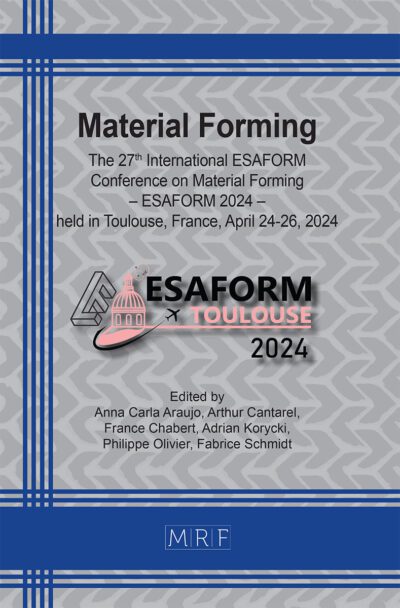Investigating the strength of adhesively bonded SMC components
Michele Tropeano, Gianluca Gatti, Luca Raimondi, Lorenzo Donati, Davide Serradimigni
Abstract. Sheet Molding Compound (SMC) has emerged as a compelling alternative to light metal alloys to produce lightweight structural components in several industries. Despite their advantages, the complexity introduced by random short-fiber reinforcement SMC materials makes their mechanical behavior challenging to predict using Finite Element Analysis (FEA) models. These challenges extend to evaluating and predicting the bonding strength of adhesive joints involving such materials, which is critical in many automotive and aerospace applications. This research proposes a methodology for generating accurate material cards for adhesives/joints. The approach integrates experimental testing, numerical modeling, and optimization. A three-phase process was employed, utilizing software such as HyperMesh, Abaqus, and HyperStudy. The optimization phase involved the Design of Experiments (DOE) to explore parameter spaces, fitting to construct response surfaces, and optimization algorithms to refine material properties for curve matching. Despite the challenges posed by the brittle nature of SMC substrates, the approach successfully captured the joint’s mechanical behavior, producing a reliable material card for this specific material combination. This study underscores the potential of the proposed methodology to predict joint strength in large-scale simulations, such as full-vehicle assemblies, with improved accuracy and reliability. By addressing the unique challenges of SMC materials, this work provides a robust framework for adhesive characterization and enhances structural designs in composite bonding applications.
Keywords
Sheet Molding Compound, Adhesives, Composite Joining
Published online 5/7/2025, 9 pages
Copyright © 2025 by the author(s)
Published under license by Materials Research Forum LLC., Millersville PA, USA
Citation: Michele Tropeano, Gianluca Gatti, Luca Raimondi, Lorenzo Donati, Davide Serradimigni, Investigating the strength of adhesively bonded SMC components, Materials Research Proceedings, Vol. 54, pp 478-486, 2025
DOI: https://doi.org/10.21741/9781644903599-52
The article was published as article 52 of the book Material Forming
![]() Content from this work may be used under the terms of the Creative Commons Attribution 3.0 license. Any further distribution of this work must maintain attribution to the author(s) and the title of the work, journal citation and DOI.
Content from this work may be used under the terms of the Creative Commons Attribution 3.0 license. Any further distribution of this work must maintain attribution to the author(s) and the title of the work, journal citation and DOI.
References
[1] Troiani E, Falaschetti MP, Taddia S, Ceruti A. CFRP Crash Absorbers in Small UAV: Design and Optimization. SAE Tech. Pap., vol. 2015–Septe, SAE International; 2015. https://doi.org/10.4271/2015-01-2461
[2] Cocchi D, Raimondi L, Brugo TM, Zucchelli A. A systematic material-oriented design approach for lightweight components and the CFRP motor wheel case study. Int J Adv Manuf Technol 2020;109:2133–53. https://doi.org/10.1007/s00170-020-05756-2
[3] Falaschetti MP, Birnie Hernández J, Semprucci F, Raimondi L, Serradimigni D, Troiani E, et al. Analysis of the Crushing Behavior of Flat Composite Plates Produced by Sheet Molding Compound. Dyn. Response Fail. Compos. Mater., Springer; 2025, p. 40–8. https://doi.org/10.1007/978-3-031-77697-7_6
[4] Staff, Gardiner G. Is the BMW 7 Series the future of autocomposites? CompositesWorld 2016.
[5] Ebrahimian F, Rodriguez S, Di Lorenzo D, Chinesta F. Optimization of precharge placement in sheet molding compound process. Int J Mater Form 2024;17. https://doi.org/10.1007/s12289-024-01836-w
[6] Galińska A. Mechanical joining of fibre reinforced polymer composites to metals—a review. Part i: Bolted joining. Polymers (Basel) 2020;12:1–48. https://doi.org/10.3390/polym12102252
[7] Raimondi L, Tomesani L, Zucchelli A. Enhancing the Robustness of Hybrid Metal-Composite Connections Through 3D Printed Micro Penetrative Anchors. Appl Compos Mater 2024. https://doi.org/10.1007/s10443-024-10224-1
[8] Raimondi L, Tomesani L, Donati L, Zucchelli A. Lattice material infiltration for hybrid metal-composite joints: Manufacturing and static strenght. Compos Struct 2021;269:114069. https://doi.org/10.1016/j.compstruct.2021.114069
[9] Cole RT, Bateh EJ, Potter J. Fasteners for composite structures. Composites 1982;13:233–40. https://doi.org/10.1016/0010-4361(82)90005-2
[10] Lopes VHP, Campilho RDSG, Nóvoa PJRO, Rocha RJB, Sánchez-Arce IJ. Experimental and cohesive zone modelling study on composite joining by co-curing and adhesive bonding for sheet moulding compound or carbon-fibre prepreg laminates. J Adhes Sci Technol 2023;37:1593–613. https://doi.org/10.1080/01694243.2022.2081446
[11] Jyoti A, Gibson RF, Newaz GM. Experimental studies of Mode I energy release rate in adhesively bonded width tapered composite DCB specimens. Compos Sci Technol 2005;65:9–18. https://doi.org/10.1016/j.compscitech.2004.04.006
[12] Campilho RDSG, Banea MD, Pinto AMG, Da Silva LFM, De Jesus AMP. Strength prediction of single- and double-lap joints by standard and extended finite element modelling. Int J Adhes Adhes 2011;31:363–72. https://doi.org/10.1016/j.ijadhadh.2010.09.008
[13] Faneco TMS, Campilho RDSG, Silva FJG, Lopes RM. Strength and fracture characterization of a novel polyurethane adhesive for the automotive industry. J Test Eval 2017;45:398–407. https://doi.org/10.1520/JTE20150335
[14] International A. ASTM D5528-01(07). Stand Test Method Mode I Interlaminar Fract Toughness Unicirectional Fiber-Reinforced Polym Matrix Compos 2007;D 5528-0:12.
[15] ASTM. D 7905 Standard Test Method for Determination of the Mode II Interlaminar Fracture Toughness of Unidirectional Fiber-Reinforced Polymer Matrix Composites. ASTM Stand 2012;i:1–16.
[16] ASTM. D3165 Standard Test Method for Strength Properties of Adhesives in Shear by Tension Loading of Single-Lap-Joint Laminated Assemblies 1 2012;2:1–4. https://doi.org/10.1520/D3165-07R14.2
[17] Olsson AMJ, Sandberg GE. Latin Hypercube Sampling for Stochastic Finite Element Analysis. J Eng Mech 2002;128:121–5. https://doi.org/10.1061/(asce)0733-9399(2002)128:1(121)
[18] Gu Z, Liu Y, Hughes DJ, Ye J, Hou X. A parametric study of adhesive bonded joints with composite material using black-box and grey-box machine learning methods: Deep neuron networks and genetic programming. Compos Part B Eng 2021;217. https://doi.org/10.1016/j.compositesb.2021.108894
[19] Liu Y, Gu Z, Hughes DJ, Ye J, Hou X. Understanding mixed mode ratio of adhesively bonded joints using genetic programming (GP). Compos Struct 2021;258:113389. https://doi.org/10.1016/j.compstruct.2020.113389
[20] Mandolfino C, Cassettari L, Pizzorni M, Saccaro S, Lertora E. A Response Surface Methodology Approach to Improve Adhesive Bonding of Pulsed Laser Treated CFRP Composites. Polymers (Basel) 2023;15. https://doi.org/10.3390/polym15010121
[21] Mandolfino C, Cassettari L, Lertora E, Pizzorni M. Adhesive bonding of glass-fibre thermoplastic composite: process optimisation and sustainability analysis using LCA methodology. Int J Adv Manuf Technol 2024;130:5709–26. https://doi.org/10.1007/s00170-024-13022-y
[22] Raimondi L, Bernardi F. Advanced hybrid laminates : elastomer integration for optimized mechanical properties. Int J Adv Manuf Technol 2025:3177–95. https://doi.org/10.1007/s00170-025-15023-x
[23] Benzeggagh ML, Kenane M. Measurement of mixed-mode delamination fracture toughness of unidirectional glass/epoxy composites with mixed-mode bending apparatus. Compos Sci Technol 1996;56:439–49. https://doi.org/10.1016/0266-3538(96)00005-X












